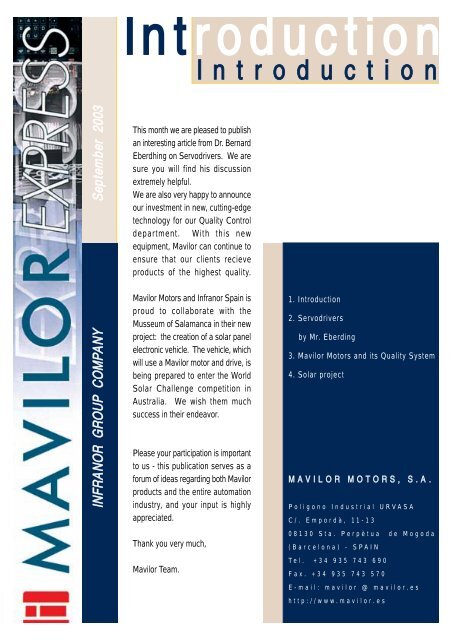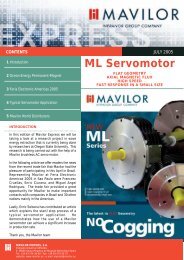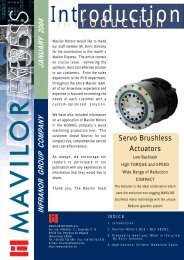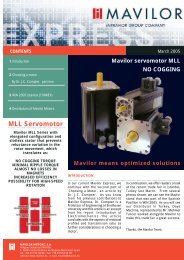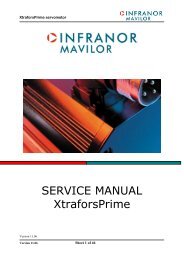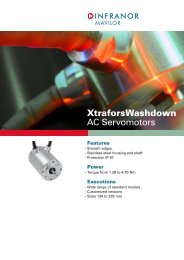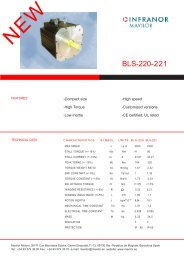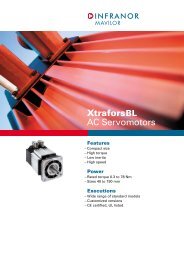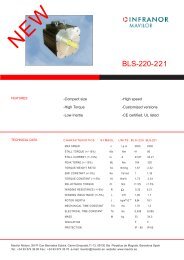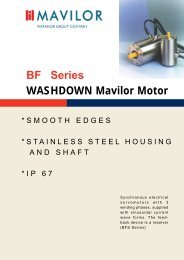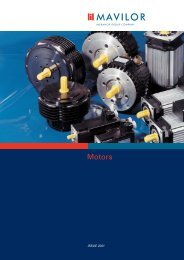Introduction - Mavilor
Introduction - Mavilor
Introduction - Mavilor
Create successful ePaper yourself
Turn your PDF publications into a flip-book with our unique Google optimized e-Paper software.
In t r o d u c t i o n<br />
I n t r o d u c t i o n<br />
INFRANOR GROUP COMPANY September 2003<br />
This month we are pleased to publish<br />
an interesting article from Dr. Bernard<br />
Eberdhing on Servodrivers. We are<br />
sure you will find his discussion<br />
extremely helpful.<br />
We are also very happy to announce<br />
our investment in new, cutting-edge<br />
technology for our Quality Control<br />
department. With this new<br />
equipment, <strong>Mavilor</strong> can continue to<br />
ensure that our clients recieve<br />
products of the highest quality.<br />
<strong>Mavilor</strong> Motors and Infranor Spain is<br />
proud to collaborate with the<br />
Musseum of Salamanca in their new<br />
project: the creation of a solar panel<br />
electronic vehicle. The vehicle, which<br />
will use a <strong>Mavilor</strong> motor and drive, is<br />
being prepared to enter the World<br />
Solar Challenge competition in<br />
Australia. We wish them much<br />
success in their endeavor.<br />
Please your participation is important<br />
to us - this publication serves as a<br />
forum of ideas regarding both <strong>Mavilor</strong><br />
products and the entire automation<br />
industry, and your input is highly<br />
appreciated.<br />
Thank you very much,<br />
<strong>Mavilor</strong> Team.<br />
1. <strong>Introduction</strong><br />
2. Servodrivers<br />
by Mr. Eberding<br />
3. <strong>Mavilor</strong> Motors and its Quality System<br />
4. Solar project<br />
M A V I L O R M O T O R S , S . A .<br />
Poligono Industrial URVASA<br />
C/. Empordà, 11-13<br />
08130 Sta. Perpètua de Mogoda<br />
(Barcelona) - SPAIN<br />
T el. +34 935 743 690<br />
Fax. +34 935 743 570<br />
E-mail: mavilor @ mavilor.es<br />
http://www.mavilor.es
SERVODRIVES<br />
M A V I L O R EXPRESS<br />
Servo motor selection and dynamic points of view<br />
BERND EBERDING (MESA GmbH)<br />
Fig.1: Simplified structure of position controller circuit via current cascade<br />
adjustment and speed control.<br />
Machine manufacturers are increasingly called upon to<br />
design systems for optimal time utilization. However,<br />
there are often conflicts between shortening the<br />
acceleration and positioning time and the limits of the<br />
mechanical system. The resulting torsional resonances<br />
represent greater mechanical force and must be avoided.<br />
This article attempts to clarify the influence of servo<br />
motor design on the dynamic behaviour of the drive,<br />
by comparing disc motors and DC conventional electric<br />
motors.<br />
The following parameters are of interest in this study:<br />
o Constructed length<br />
o Shaft diameter<br />
o Moment of inertia<br />
o Electrical time constant<br />
Key data on the motors compared are listed in the table.<br />
Figure 1 shows the simplified structure of a position<br />
controller circuit via current cascade adjustment and<br />
speed control.<br />
mM<br />
Jm<br />
Fig.2: Simplified mechanical structure of a servo motor<br />
Controller theory states that the maximum step frequency<br />
of the loop cascade controller is w = w. Therefore, the<br />
step frequency of the internal controller loop must be<br />
maximized. This is also necessary when the exterior<br />
controller loop has less stringent requirements, as this<br />
will reduce the force exerted on all components, provide<br />
better suppression of interference and increase the<br />
stability - all of which make the system easier to handle.<br />
As the internal controller loop, the current controller<br />
circuit should have the widest possible bandwidth.<br />
Modern servo amplifiers have values of 1-2 kHz, which<br />
depend not only on the switching frequency used (fs<br />
preferably ³ 8 kHz), but also on the load. A comparison<br />
of the time constants clearly shows lower values (see<br />
table) for the disc motors (ironless rotor). This allows<br />
current controller circuits with larger bandwidths to be<br />
designed.<br />
C<br />
Jt<br />
mW<br />
Motor Type NN PN La Ra large Shafts Jm Te fres<br />
Nm kW mH Ω mm mm Kg cm2 ms Hz<br />
Disc motors 3.8 1.2 0.2 0.7 127.5 24 24.4 0.27 140<br />
Conventional 3.6 1.2 1.5 0.25 230 19 20.5 6.8 80<br />
electric motors<br />
Table: Key technical data of comparable disc motors and conventional<br />
electric motors
SolarZep Project<br />
MAVILOR MOTORS AND INFRANOR SPAIN<br />
COLLABORATION MUSSEUM OF SALAMANCA<br />
M A V I L O R EXPRESS<br />
"How do you design a car?"<br />
"Whom do you design a car or motorcycle<br />
for?"<br />
With each new exhibition, The Museum of<br />
Automobile History of Salamanca seeks to<br />
bring a new aspect of the world of automation<br />
to the public. Automobile design is an<br />
important part of the museum's focus, so it<br />
is fundamental to educate the public about<br />
the creative process involved in bringing a<br />
possibilities of an electronic vehicle are shown<br />
in our new project: the design and<br />
construction of an electronic vehicle powered<br />
by solar panels. The specifications of the<br />
vehicle are quite high, starting with a chassis<br />
made of computer-optimised steel tubes. It<br />
has a body surface of 1 m2, comprised of<br />
laminated aluminium that alternates with eight<br />
solar modules.<br />
MA - 55<br />
new car into the market. The multiple
M A V I L O R EXPRESS<br />
The new digital microscope will allow us to carry out visual verifications with a significant<br />
improvement in presentation quality.<br />
At the same time, we will be able to save the images in a digital format, which we can<br />
then send to suppliers or clients via e-mail.<br />
This equipment serves to implement optical measurement and quality control programs<br />
for all our products.
The speed control circuit is the<br />
second controller loop, and the<br />
high bandwidth of the current<br />
controller can be utilized in this<br />
case. Figure 2 shows the simplified<br />
mechanical structure of a servo<br />
motor.<br />
The moment of inertia of the<br />
motor, JM, is flexibly coupled to<br />
the moment of inertia of the<br />
tachometer, JT, creating a vibrating<br />
system. The natural frequency of<br />
this system must be taken into<br />
account, as it has significant<br />
influence on dynamic behaviour.<br />
For the natural frequency ω ,<br />
ω = √ C (JM + JT)<br />
JM · JT<br />
Conventional electric motors<br />
Two options for maximizing the<br />
natural frequency can be deduced<br />
from this relationship. This has the<br />
following design-related<br />
advantages for the disc motor:<br />
The reduced length (e.g., Factor<br />
2) allows a 2 increase in shaft<br />
diameter with the same mass<br />
inertia. Since the polar moment of<br />
inertia increases with the 4th power<br />
of the diameter, torsional stability<br />
is increased four-fold.<br />
The natural frequency of the<br />
system is higher, resulting in<br />
improved system properties. This<br />
is shown in Figures 3 and 4.<br />
The same considerations should<br />
be made for the motor-load system.<br />
This allows relevant mechanical<br />
drive requirements to be taken into<br />
account. A direct relationship<br />
between the minimum positioning<br />
time achievable and the natural<br />
frequency can be established for<br />
each system.<br />
MAVILOR EXPRESS<br />
<strong>Mavilor</strong> Motor MA
Tachometer<br />
voltage<br />
M A V I L O R EXPRESS<br />
Armature<br />
current<br />
Fig. 3: Tachometer voltage and armature current of a DC disc motor<br />
Natural frequency: ** 143 Hz<br />
Higher accelerations lead to<br />
resonance, increasing the positioning<br />
times. The resonance that appears is<br />
generally offset with the<br />
corresponding specification for the<br />
rated values (ramps). The<br />
measurements also showed that<br />
conventional electric motors tend to<br />
experience vibration in a wider<br />
margin of amplification, P, of the<br />
speed control circuit, unlike disc<br />
motors. Moreover, sudden<br />
interruption of this vibration was also<br />
not observed when the amplification,<br />
P, typical in disc motors, is reduced.<br />
This behaviour makes it hard to<br />
adjust the speed controller circuit<br />
and may cause unwanted vibration<br />
Fig. 5: Infranor disc motor, AM Series<br />
to appear during operation. In this<br />
context, therefore, the following<br />
selection criteria can be established<br />
for servo motors:<br />
o Elevated torsional stability (short<br />
design, larger shaft diameter)<br />
o Low mass inertia<br />
o Low inductivity (and therefore<br />
larger bandwidth for the current<br />
controller circuit)<br />
o Lower mass of the tachometer<br />
generator (measurement system<br />
in general)<br />
o Stablest possible coupling of the<br />
measurement system to the<br />
motor shaft (hollow-bored shaft<br />
mounting)<br />
Fig. 4: Tachometer voltage and armature current<br />
of a conventional DC electric motor<br />
These requirements were taken into<br />
account in the design of the disc<br />
motors of the MO, MT, MS (DC),<br />
SE and AM (AC) series (Fig. 5).<br />
Therefore, these motors meet the<br />
necessary dynamic requirements for<br />
modern drive systems, achieving<br />
lower acceleration and positioning<br />
times, greater precision and good<br />
system stability and handling.
M A V I L O R EXPRESS<br />
<strong>Mavilor</strong> modernizes its Quality analysis system.<br />
<strong>Mavilor</strong> has invested in new verification<br />
equipment for the quality control department,<br />
including a digital microscope (power: x100).<br />
This improvement in analytical instruments<br />
allows for the visual verification of all system<br />
components in order to achieve the highest<br />
possible quality in all of our products.
M A V I L O R EXPRESS<br />
MA - 55<br />
The panels provide a peak power of 1kW. The<br />
aerodynamic aspects of the vehicle have been<br />
optimised using computational methods to a<br />
coefficient of aerodynamic resistance of<br />
Cd=0.11, 1.0, giving it almost no resistance.<br />
Technical Characteristics are:<br />
Acceleration: from 0-50 km/h in 8 seconds<br />
Mileage with full tank: 50 km<br />
Motor: 5kW brushless radial flow motor donated<br />
by <strong>Mavilor</strong> Motors<br />
Drive: motor comes with its own drive<br />
Solar panel efficiency: 10%<br />
Type: sports car<br />
Capacity: one passenger<br />
Dimensions: 600x200x125 mm<br />
Weight (kg): 550 kg<br />
Battery weight (kg): 150 kg<br />
Type of battery: Pb-acid Orbital donated by<br />
Tudor<br />
Maximum speed: 80 m/s<br />
This unique prototype represents the first phase<br />
of an ambitious project that will optimise all of<br />
the vehicle's characteristics to compete in the<br />
World Solar Challenge in Australia.


